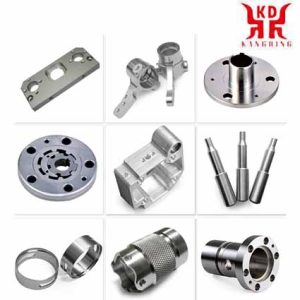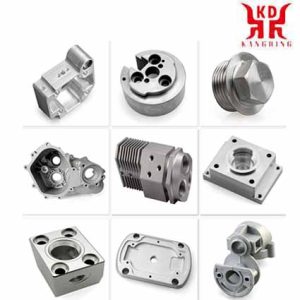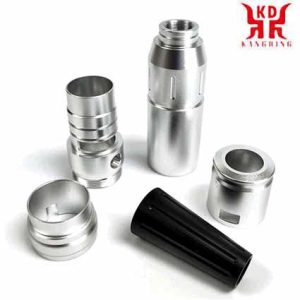Что такое обработка алюминия и каковы ее основные функции?? Применение алюминиевых деталей и анализ технологии обработки с ЧПУ.
Для выполнения процесса обработки алюминиевых деталей., необходимо знать физические характеристики обрабатываемого материала, что важно при выборе инструментов, углы резки, скорости, среди других параметров. Некоторые важные аспекты обработки алюминия описаны ниже..
Физические характеристики алюминия

Алюминиевые детали
Алюминий является одним из наиболее часто используемых металлов благодаря своим особым физическим характеристикам.:
– Отличная теплопроводность, который может достигать до 230 Вт / м К., Эта характеристика позволяет ему очень хорошо справляться с задачами по отводу тепла., used for the manufacture of auto parts such as radiators for cars in the automotive industry, also in Component heat sinks in the mechanical, electrical and especially electronics industries.
– Highly resistant to corrosion in humid environments, except in the presence of hydrochloric acid or alkalis. When it is in the open air a layer of aluminum oxide is formed which prevents its corrosion process, this property allows aluminum an excellent performance in mechanical and architectural industries.
– It is a good electrical conductor, its electrical conductivity is approximately 35 м / Ω mm2, which makes it an excellent candidate for applications of generation, transport and use of electrical energy.
– It is also a low-density metal (2,700 kg / m3), it has low mechanical resistance but is easily improved by alloying processes, allowing it to reach up to 690 МПа. Its weight is close to a third of the weight of steel, these characteristics make it especially useful in the aerospace and automotive industry, since its lightness contributes to energy savings in transport.
– The hardness of aluminum ranges from HB = 15 for very pure soft aluminum to approximately HB = 110 for 7075 alloyed (AlZnMgCu) and thermally hardened aluminum.
– The ductility or elastic limit of aluminum is approximately 0.2%, it is highly deformable, a very useful property in the production of electrical conductors, mechanical systems to absorb impact energy, среди прочего.
– The excellent malleability of aluminum makes it useful in the production of thin sheets used as aluminum foil, tin cans for the food industry.
– Its melting point is rather low, around 660ºC, поэтому для производства деталей с помощью процессов впрыска и экструзии металла требуется мало энергии..
Потому что он очень распространен в природе и его легко восстановить в процессе переработки., это недорогой металл.
Благодаря своим характеристикам, алюминий стал металлом, широко используемым в промышленности для производства деталей за счет использования различных производственных процессов, таких как литье под давлением., экструзия и механическая обработка.
Для обработки алюминия, требуется относительно мало энергии, так как добиться распила материала благодаря его механическим характеристикам, он использует треть энергии по сравнению с энергией, используемой при обработке стали. Обработку алюминия можно осуществлять на высоких скоростях и с использованием стартовых чашек без создания чрезмерных напряжений между материалом и режущим инструментом.. Высокая скорость обработки означает более высокую производительность и лучшее качество поверхности..

Обработка алюминиевых деталей
Режущие инструменты для обработки алюминия
Обработка алюминия требует, чтобы инструмент имел определенные специальные характеристики.. Желательно, чтобы режущие инструменты, используемые для этого типа материалов, позволяли эффективно удалять материал во избежание затупления, которое может привести к разрушению детали и режущего инструмента., так же, передние углы должны быть больше, чем те, которые используются для обработки сталей..
Благодаря высокой теплопроводности алюминия, процесс охлаждения режущего инструмента не требует слишком большого потока охлаждающей жидкости, just enough to evacuate detached material.
In the market there are a variety of cutting tools with different properties and costs. For the machining processes of aluminum, like steel, it is desirable that the tools are very efficient and durable over time. Thanks to technological advances, it is possible to find tools with hard coatings such as DLC (diamond like carbon). that provide hardness and tribological properties to the tool, up to complex coating processes such as PVD (vapor deposition) treatments, with which titanium nitride coatings capable of protecting the tool with surface layers with titanium are achieved. Some materials for cutting tools for aluminum are:
High-speed steels are special high-performance steels with high hardness up to 500 ºC and high resistance to wear thanks to alloying elements such as tungsten, molybdenum, vanadium and chromium, capable of forming carbides. Cobalt is added to increase hardness. HSS tools are suitable for machining low-silicon aluminum alloys. Supports the use of large rake angles for better cutting conditions.
Carbide is a mixture of tungsten carbide and cobalt (CW + Co). This coating provides longer tool life. They are used in the machining of aluminum with high silicon content and for machining at high cutting speeds.
Алмаз, polycrystalline diamond (PCD) is obtained by sintering fine powders of granulated diamond crystals at high temperatures and pressures into the desired shape. Diamond tools are characterized by their long life, even when used in the machining of alloys with a high silicon content. They are normally used for finishing work on aluminum alloys that generate long chips, or for automatic machines working with aluminum that generate short chips.
In conclusion, it can be said that thanks to the physical and mechanical properties of aluminum, it is one of the metals most used by humanity in numerous fields of industry, therefore it is one of the metals that are most mechanized in production processes. Aluminum machining processes require much less energy than that used in steel machining, it is carried out at high cutting and feed speeds, providing quality surface finishes.

Die-cast aluminum parts
Mechanical properties
Aluminum is a relatively soft and tough metal. The tensile strength of absolutely pure aluminum is 45 N / mm², the yield point is 17 N / mm² and the elongation at break is 60%. в то время как предел прочности технически чистого алюминия составляет 90 N / mm², the yield point is 34 N / mm² and the elongation at break is 45%. Предел прочности его сплавов, с другой стороны, до 710 N / mm² (сплав 7068). Его модуль упругости составляет около 70 ГПа, значение, которое часто цитируется. Значение 66.6 ГПа дано для чистого алюминия., но значения варьируются от 60 к 78 ГПа. G-модуль 25.0 кН / mm², коэффициент Пуассона 0.35.
Тепловые свойства
Температура плавления 660.2 °С, а температура кипения 2470 °С. Температура плавления значительно ниже, чем у меди. (1084.6 °С), чугун (1147 °С) и железо (1538 °С), что делает алюминий хорошим литейным материалом.
При температуре перехода 1.2 К, чистый алюминий становится сверхпроводником.
Теплопроводность относительно высока 235 Вт / (К м). Теплопроводность меди примерно в два раза выше., но его плотность примерно в четыре раза больше, вот почему алюминий используется для теплообменников в транспортных средствах. The coefficient of thermal expansion is quite high due to the very low melting point of 23.1 µm • m − 1 • K − 1.
The shrinkage, то есть. the decrease in volume when solidifying, is 7.1%.

Turning aluminum and aluminum alloy parts
Aluminum alloys
Aluminum alloys are alloys that mainly consist of aluminum.
Aluminum can be alloyed with numerous metals to promote certain properties or to suppress other undesirable properties. With some alloys, the formation of the protective oxide layer (passivation) is severely disturbed, which means that the components made from them are sometimes at risk of corrosion. Almost all high strength aluminum alloys are affected by the problem.
There are wrought aluminum alloys that are intended for further processing by rolling, forging and extrusion, and cast materials. These are used in foundries.
В общем, aluminum alloys are divided into two large groups of wrought and cast alloys:
Cast aluminum alloys. Typical cast aluminum alloys contain silicon as the main alloying element (AlSi), but there are also types with copper or magnesium as cast alloys. [48] [63]
Wrought aluminum alloys, they have a share of about 75% and are further subdivided according to the main alloy element (с) into
Pure aluminum with an aluminum content of 99.0% к 99.9%. They are very easy to work with, have low strength and good corrosion resistance.
Aluminum-copper alloys (AlCu): They have medium to high strength, can be hardened, but are susceptible to corrosion and difficult to weld. They can contain magnesium or manganese additives.
Aluminum-manganese alloys (AlMn): They have low to medium strength, are corrosion-resistant and easy to process.
Aluminum-magnesium alloys (AlMg, without AlMgSi): They have medium strengths, cannot be hardened, are corrosion-resistant, easy to form and weld. Most types also contain manganese (AlMg (Mn)).
Aluminum-magnesium-silicon alloys (AlMgSi): They have medium to high strengths, are easy to process by welding and extrusion, can be hardened and are corrosion-resistant.
Aluminum-zinc-magnesium alloys (AlZnMg): Copper-free types have medium to high strengths and are easy to weld. Grades containing copper (AlZnMg (Cu)) have high strengths – in the case of 7075 over 500 МПа – cannot be processed by fusion welding, but can be machined (фрезерование, бурение).
Special alloys, for example aluminum-lithium alloys with a particularly low density, or free-cutting alloys that are particularly easy to machine.
A distinction is also made between naturally hard alloys – which cannot be hardened by heat treatment – and hardenable alloys:
Типичными естественными твердодеформируемыми алюминиевыми сплавами являются: AlMg, AlMn, АлМгМн, AlSi
Закаливаемые деформируемые сплавы – повышение прочности за счет дисперсионного твердения элементов сплава с дополнительным стареющим отжигом при 150 к 190 °С. Типичными прокаливаемыми деформируемыми алюминиевыми сплавами являются:: AlMgSi, АлКуМг, AlZnMg. Первый высокопрочный, закаленный алюминиевый сплав AlCuMg получил торговое название Duraluminium., или сокращенно «Дюрал»., в 1907.
Экономический смысл
После стали, алюминий — второй по важности металлический материал. В 2016, 115 миллионов тонн было произведено во всем мире.

Поверхностная обработка алюминиевых деталей
Обрабатываемость алюминия и алюминиевых сплавов
Токарная обработка алюминия
Механическая обработка включает токарную обработку., сверление и фрезерование. Алюминиевые материалы легко поддаются механической обработке.. Однако, их точные свойства зависят от сплава и состояния структуры.. Следует отметить, что температуры, возникающие во время обработки, могут быстро оказаться в диапазоне температуры плавления.. With the same cutting parameters as with steel, однако, aluminum results in lower mechanical and thermal stress. Tungsten carbide is often used as a cutting material for hypoeutectic alloys or diamond for hypereutectic alloys that wear heavily. The machining of anodized workpieces in particular requires hard tools in order to avoid wear and tear from the hard anodized layer. The grinding dust generated when grinding aluminum can lead to an increased risk of explosion.
Aluminum and aluminum alloys are considered to be easy to machine. It is an important construction material, especially in the aerospace industry and in vehicle construction, which is well suited for lightweight construction. Up to 90% of the raw parts are machined. Однако, low-strength grades can form long chips and tend to stick to the cutting edge. Силы резания обычно низкие., износ зависит от конструкции. Алюминий и его сплавы хорошо подходят для высокоскоростной обработки.. Температура воздуха составляет всего около 300 °С, что очень низко по сравнению с температурами, возникающими при работе со сталью., но относительно высокая по сравнению с температурой плавления алюминиевых сплавов (580 °С до 660 °С). Скорость резания может варьироваться в широких пределах.; вниз оно ограничено образованием наростов, вверх – температурой плавления.. Несмотря на низкие силы резания, необходимы приводы из-за высоких скоростей резания, которые должны обеспечивать примерно в пять раз большую мощность, чем необходима для обработки стали.. Быстрорежущие стали используются в качестве режущих материалов при простой механической обработке, например сверлении.. Часто твердые сплавы изготавливаются на основе карбида вольфрама.. С другой стороны, марки с титаном или танталом не подходят, поскольку эти элементы вступают в химические реакции с алюминием. Поэтому покрытия также не подходят.. Режущая керамика также не является химически стойкой и очень быстро изнашивается.. Алмаз, с другой стороны, хорошо подходит для обработки алюминия и применяется благодаря очень длительному сроку службы и высокому качеству поверхности.. Это особенно выгодно при обработке зеркал.. Износ обычно небольшой., но некоторые сплавы содержат твердые, абразивные присадки, которые увеличивают износ, но улучшают стружкоотделение. Износ практически всегда происходит на открытом пространстве.; Кратерный износ возникает только при использовании высокоабразивных конструктивных элементов при высоких скоростях резания..

Прецизионные алюминиевые детали
Точные условия сильно зависят от сплава..
Soft materials such as the non-hardenable wrought alloys and the hardenable in the soft state tend to produce long chips and the formation of built-up edges. The surface quality is rather poor, at high cutting speeds it can be improved. If possible, such materials are machined after cold forming, as the work hardening leads to more favorable chip shapes and surfaces.
Stronger materials such as hardened wrought alloys are usually easier to machine
Cast alloys often contain silicon which has an abrasive effect. The higher the silicon content, the higher the tool wear. The chip shapes are good.
Since aluminum tends to stick, it is often machined with a large rake angle.
 English
English العربية
العربية 中文(漢字)
中文(漢字) Čeština
Čeština Dansk
Dansk Nederlands
Nederlands Suomi
Suomi Français
Français Deutsch
Deutsch Italiano
Italiano 日本語
日本語 ಕನ್ನಡ
ಕನ್ನಡ 한국어
한국어 Português
Português Русский
Русский Slovenčina
Slovenčina Español
Español Svenska
Svenska Türkçe
Türkçe

